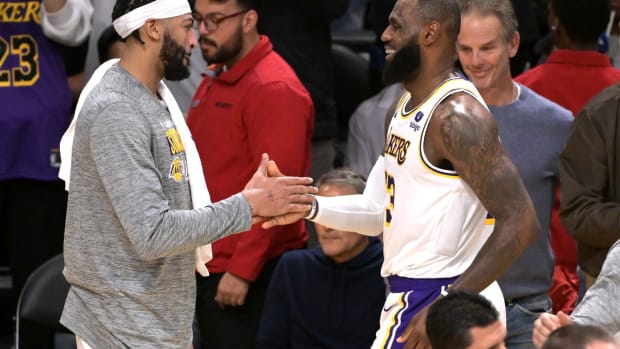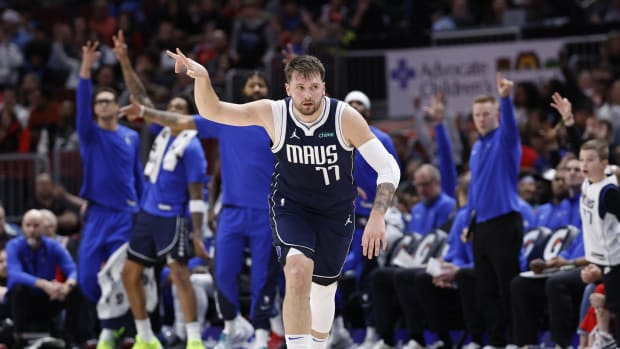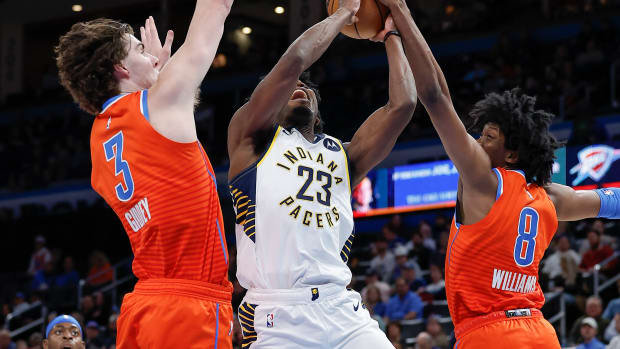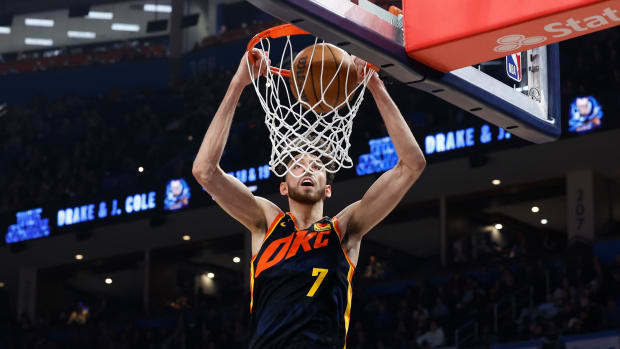2018 NBA Draft Superlatives: Biggest Sleeper, Safest Pick And More
Evaluating draft prospects is an unscientific process that entails a fair bit of guesswork. One guard’s balky shooting form may be a correctable flaw, while one center’s shoddy defensive awareness could prove a more lasting problem. Those deficiencies must be weighed against the strengths that could turn players into superstars, starters or valuable bench contributors on NBA rosters.
In some cases, prospects possess certain qualities, good or bad, that feel certain to translate to the next level. Maybe it’s a big man’s rebounding prowess or a wing’s lockdown man-to-man defense. The Crossover’s Front Office endeavored to identify those qualities in this year’s draft class when compiling its 2018 draft superlatives. Some of the categories listed below are straightforward, while others are more obscure. Hopefully they provide some guidance in sorting through the names your favorite team may be considering on draft night.
Best Scorer: Trae Young
Young became the biggest story in college basketball last season by laying waste to opposing defenses with volcanic scoring sprees. There was the 43-point eruption against Oregon on a neutral court, the 39-point explosion at Texas Christian and the controversial, 48-point outburst at rival Oklahoma State (which required 39 shots).
As Young kept burying teams in truckloads of points, it wasn’t clear whether he’d be able to keep up the torrid pace that drove his progression from a low-key box-score curiosity into a headlining statistical marvel. He did, finishing the season with a Division I-leading average of 27.4 points per game.
The biggest problem Young poses for opponents is the danger created by the threat of his jump shot. Defenders who back off him in an attempt to gain an advantage on an anticipated drive risk letting Young pull up for a deep three. His ability to rise and fire off the bounce in a compact motion could make him a potent screen-and-roll operator, and it also helps to explain why he is so often compared to Golden State Warriors point guard Steph Curry. Young won’t have as much rope to hunt shots in the NBA as he did at Oklahoma, where he used a nation-high 37.1% of his team’s possessions while he was on the floor, according to Sports Reference, but few players in this class stand a better of chance of being an effective bucket-getter from the jump.
Best 3-and-D Prospect: Mikal Bridges
There is no team for whom selecting Bridges on draft night would not make a whole lot of sense. His game is transportable to today’s NBA in obvious ways. Coaches who run switch-heavy defensive schemes would jump at the opportunity to roll out a 6’7’’ wing with a 7’0’’ wingspan who can stay in front of ball handlers on the perimeter and check burly forwards on rampages to the basket. Bridges might be able to guard as many as four positions.
Setting aside individual assignments, he’s a menace away from the ball who can clog up passing lanes and cover ground in a hurry to challenge shots. What Bridges brings to the table on defense is probably enough, in itself, to tempt general managers, but he could become a functional component of a high-level offense.
Bridges is a credible floor-spacer who rated out as the No. 2 scorer (17.7 points per game) and most accurate three-point shooter (43.5 3P%) on a Villanova team that led the country in Ken Pomeroy’s adjusted points per possession. He’s comfortable running off screens and launching off the catch, and a high release point gives him an edge when defenders are in range to contest. Bridges’s blend of long-range shooting and malleability on defense should lead to him being the next wing off the board after Missouri freshman Michael Porter Jr., though other Front Office writers would suggest otherwise.
2018 NBA Mock Draft 9.0: Trade Speculation Heats Up
Safest Pick: Jaren Jackson Jr.
The path for Jackson locking down a spot in a team’s starting lineup for a decade or more is straightforward. Because of his physical dimensions (6’11’’ with a 7’5’’ wingspan) and mobility, Jackson is unlikely to have any trouble switching between as many as three positions on defense. That should keep him on the floor against opponents who can spread the floor with shooters in smaller lineups or try to use pick and rolls to drag big men into unfavorable one-on-one matchups. Maybe an even bigger defensive asset is Jackson’s shot blocking.
He’s an anticipatory rim defender and veritable drive-deterrer with sound positioning who can quickly leap off the floor to contest floaters, layups and dunks. Over 35 games at Michigan State last season, he swatted 14.3% of opponents’ two-point field goal attempts while he was on the court, the second-highest percentage in the country.
Likewise, the offensive benefits Jackson offers are plain. He’s a legitimate deep shooting threat, having canned 39.6% of his 96 three-point attempts last season. Jackson also sank 79.7% of his 133 free-throw attempts, a strong clip for a five. Beyond Jackson’s offensive and defensive traits, he’s an enticing prospect because of his age. Jackson is one of the youngest prospects in this class; he won’t turn 19 until the middle of September.
Best Shot-Blocker: Mohamed Bamba
The reason Bamba stands alone among shot-blockers in this year’s draft class has a lot to do with the biggest story coming out of the pre-draft combine the NBA staged in Chicago last month.
Anyone who had caught a glimpse of Bamba in high school or at Texas last season knew he had freakishly long arms, but this year’s event confirmed that Bamba has a longer wingspan, 7’10’’, than any other player ever measured at the combine. (At the 2013 combine, the most popular comp for Bamba, Utah Jazz center Rudy Robert, checked in with a 7’8.5’’ wingspan and 9’7’’ standing reach, compared to 9’7.5’’ for Bamba.) That comic-book length makes Bamba a uniquely devastating rim-protecting force, but it wouldn’t amount to all that much were it not accompanied by the timing and agility to set his feet before rising up to deny would-be scorers.
As a freshman with the Longhorns last season, Bamba blocked 13.1% of opponents’ two-point field goal attempts while he was on the court, which ranked third in the country, as he powered an offensively deficient (89th in Pomeroy’s adjusted efficiency) team to the NCAA tournament. Bamba’s capacity for spooking ball handlers out of basket-attacks, swallowing up bigs looking for clean short-range looks and barricading the rim should turn him into the anchor of a stingy defense.
There's Never a Bad Time With Deandre Ayton
Best Rebounder: Deandre Ayton
Ayton’s glass-cleaning prowess is predicated on his physical tools. At Arizona, he towered over most opposing power forwards and centers with his 7’0.5’’, 261-pound frame, and most pro big men will be at a physical disadvantage against him. Ayton’s imposing mix of size and strength enable him to clear out space around the basket, and once he sets his feet in preparation for the ball clanging off the rim, Ayton explodes off the floor and reaches over other players with his 7’5’’ wingspan to snag the miss.
When assessing Ayton as a defensive prospect, one can argue that his ability to consistently end possessions with boards offsets, to a degree, his subpar block and steal numbers. Against Pac-12 competition last season, Ayton pulled down 26.5% of opponents misses while he was on the floor, the highest percentage in the conference.
The more Ayton proves he can consistently knock down mid- and long-range jump shots, the less time he might spend around the basket on offense, but he has shown he can produce second-chance opportunities if in position.
Ayton shined as an offensive glass-crasher with the Wildcats, grabbing 14.0% of their misses while he was on the court during Pac-12 play, the second highest percentage in the league. All told, Ayton tied Seton Hall senior Angel Delgado for the top total rebounding percentage in the high major conferences in 2017-18.
Most Star Potential Outside the Top Three: Michael Porter Jr.
The latest mock draft from The Crossover’s Front Office has the Phoenix Suns taking Deandre Ayton at No. 1, the Sacramento Kings taking Marvin Bagley III at No. 2 and the Atlanta Hawks taking Jaren Jackson Jr. at No. 3. The composition of that trio may change, but the internet mock consensus has settled, for the time being, on Porter Jr. somewhere below the top three.
Any explanation for why Porter Jr. is not cracking that exclusive tier at this stage starts with his health. A back procedure (microdiscectomy of the L3-L4 spinal disks) that Porter Jr. underwent last November, after logging two minutes in Missouri’s season opener against Iowa State, limited him to only 53 total minutes across three games.
Before the surgery, Porter Jr. was widely considered a potential candidate for the No. 1 overall pick. Had he been healthy for the Tigers in 2017-18, there’s a decent chance that would be the case today. (Sports Illustrated’s projection system had him leading all freshman with 19.3 points per game.) Instead, Porter Jr. could fall into the back half of the lottery. The team that does pick him may be getting a future All-NBA team fixture with a brighter future than most of the prospects selected earlier than him. If Porter Jr.’s back holds up long-term, he could blossom into a dangerous wing scorer who can toggle between both forward positions.
Biggest Sleeper: Lonnie Walker IV
Whether a prospect qualifies as a sleeper is a matter of perspective. Walker, for instance, is expected to hear his name called in the first round. (We have him going No. 10 in our latest mock.) For some, that may remove him from consideration. Focus on the first half of the first round, and it’s a different question. If Walker falls out of the lottery, a participant in this year’s playoffs could be on the verge of adding at minimum a low-end starter or high-end reserve who provides value on both ends of the floor.
Walker can punish defenders off the catch and off the dribble, with long-range shots and straight-line drives to the basket. Teams can’t leave him open beyond the three-point arc: He drained 39 of his 108 attempts (36.1%) from distance during ACC play with Miami last season, and he’s capable of both running off screens to fire off the catch or pulling up off the bounce. Walker also has the burst to slash into the lane and the craft to navigate shot-blockers around the basket.
There’s a lot of defensive upside with Walker, too. At the combine, he checked in 6’4.5’’ in shoes with a 6’10.5’’ wingspan, measurements that should enable him to guard as many as three positions.
NBA Draft Debate: Which Wing Would You Draft First?
Best on-Ball Defender: Jevon Carter
If Carter, a senior who’ll turn 23 before opening night next season, winds up sticking in the NBA, it will be because of his penchant for making life utterly miserable for opposing ball handlers. At West Virginia, Carter spearheaded a stifling, press-heavy defensive scheme designed to force turnovers in bunches. That system doesn’t exist at the next level, but Carter’s individual defensive ability should translate.
He is an aggressive, in-your-face nightmare for guards that he locks in on. Carter harries his mark with active hands, and he’s laterally quick enough to snuff out attempted blow-bys. Carter’s intensity doesn’t come and go; he seems to relish the opportunity to invade a PG’s airspace whenever he’s on the court. In all four of his seasons with the Mountaineers, Carter ranked in the top five among Big 12 players during conference play in steal rate, and he led the league at 3.8% as a senior.
There are other prospects in this class who, all things considered, offer more than Carter as defenders. There’s only so much a 6’1’’ point guard with a 6’4’’ wingspan can offer in coverage. Carter isn’t the sort of multi-positional ace that can facilitate seamless switches. He might be able to match up with only point guards. That shouldn’t obscure the relentlessness with which Carter hounds the opposition.
Best Senior: Chandler Hutchinson
There are no seniors projected to be taken in the lottery, and the only ones in the top 40 of the latest mock from The Crossover’s Front Office are Hutchison, West Virginia point guard Jevon Carter (No. 38) and Duke shooting guard Grayson Allen (No. 25). Hutchison is the class of that group by virtue of a well-rounded skill set that most coaches would welcome in their rotations. Hutchison took on one of the biggest offensive workloads in the country during his final season at Boise State—he used 33.2% of his team’s possessions while he was on the court, according to Sports Reference—but he won’t be asked to shoulder nearly as much responsibility in the NBA. Rather, Hutchison can stick as a complementary shooting/driving threat who can space the floor with his jumper, burn defenders on closeouts and slide between the 3 and 4 positions.
Over his four years with the Broncos, Hutchison, whom the program listed at 6’7’’, 197 pounds, jumped from hitting 28.6% of his 14 total three-point attempts as a freshman to 35.0% of his 123 three-point attempts as a senior. While he’s more comfortable firing off the catch than off the dribble, Hutchison also improved his free-throw percentage from 64.5% to 73.1%, a good indicator for his trajectory as a long-range shooter.
Biggest Unknown: Mitchell Robinson
Robinson’s convoluted journey to pro basketball involved issuing a verbal commitment to an SEC program, Texas A&M; de-committing from that program and signing with a different program in Conference USA, Western Kentucky; leaving Western Kentucky’s campus; being suspended for violating team rules; reportedly taking visits to multiple other programs before returning to Western Kentucky’s campus and deciding to skip his freshman season altogether. The net result was that Robinson—who was ranked the No. 9 recruit in the country out of Chalmette High in Louisiana, according to the 247Sports Composite, and selected to participate in the McDonald’s All-American game in 2017—bypassed D-I ball in favor of getting a jump start on preparing for the draft.
The lack of tape cast a cloud of uncertainty over his professional future, and he compounded the doubts about his game by pulling out of the combine last month and consequently depriving teams an opportunity to see him compete against other prospects in this class. In a best-case scenario, Robinson’s winding, pre-NBA journey would quickly fade into the rearview as he made good on his favorable measurables (6’11’’ with a reported 7’4’’ wingspan) by blossoming into a menacing shot-swatter and big-time lob threat. It’s just hard to say, without recent film to assess his him, how realistic that outcome is.



































